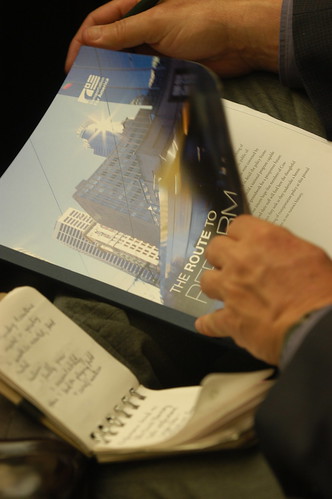Webinar Alert: Minneapolis I-35 Bridge Collapse — A Major Emergency Incident: TSAG Case Studies Workshop & Webinar
Minneapolis I-35 Bridge Collapse — A Major Emergency Incident: TSAG Case Studies Workshop & Webinar
Date: June 3, 2009
Time: 2:00–5:30 P.M. ET
Cost: All T3s are free of charge
PDH: 3.5. Webinar participants are responsible for determining eligibility of these PDHs within their professions.
Register On-line
Contact the T3 Administrator
Note: This workshop and webinar is a unique learning opportunity offered by the Transportation Safety Advancement Group (TSAG) and the U.S. DOT ITS Joint Program Office’s Talking Technology & Transportation (T3) webinars. The T3 Program is offered by the Joint Program Office’s ITS Professional Capacity Building Program. The workshop will be presented to both a live audience at the workshop location and to remote T3 webinar participants. T3 participants are invited to submit written questions before the webinar as well as during workshop question and answer periods.

Webinar participants may attend remotely for any portion of the 3.5 hour workshop/webinar. An audio of the event’s proceedings, synchronized with its presentations, will be available in the T3 Webinar archives approximately 4 weeks after the workshop.
Background
The Transportation Safety Advancement Group (TSAG) is facilitated and administered by the Intelligent Transportation Society of America (ITS America) to provide input to the US Department of Transportation (US DOT), ITS Joint Program Office’ Public Safety mission. TSAG advises the US DOT on the development and deployment ITS technologies that optimize travel mobility, safety / security, economy and environmental quality. Through its broad membership comprised of transportation and public safety professionals, TSAG initiates programs that promote inter-disciplinary, inter-agency and inter-jurisdictional coordination and cooperation, and that promote partnerships for advancing surface transportation services technologies. TSAG operates through resources provided by the US Department of Transportation and serves its program mission in compliance with US DOT regulations, policies and specified contract provisions.
I-35 Bridge Collapse Case Studies Workshop & Webinar Overview
Within a workshop setting, TSAG members and other public safety professionals review actual public safety related events or incidents for the purpose of identifying management strategies and technology-based applications and corresponding successes, failures, and lessons-learned. The June 3, 2009 Workshop will review the 2007 I-35 (MN) Bridge Collapse.
On August 1, 2007, the Interstate 35W Bridge collapsed into the Mississippi River during rush hour in the City of Minneapolis. The 1,907-foot bridge fell into the Mississippi River and onto roadways below. The span was packed with rush hour traffic, and dozens of vehicles fell with the bridge leaving scores of dazed commuters scrambling for their lives.
Case Studies Workshop presenters walk the audience through the tragic events of the day, focusing on 9-1-1 operations, Police, Fire, and EMS response, as well as the Emergency Operations Center (EOC) activation and management. Presenters will share lessons learned and highlight the performance of the Minneapolis 911 Center, of local emergency responders and of operations strategies and technologies at the time of and responding to the incident.
Target Audience
Workshop participants include TSAG members and guests. Webinar target audience includes other state and local public safety interests, including public safety managers and transportation operations, emergency communications, and emergency public safety practitioners.
TSAG Case Study Workshop Concept and Objectives
The TSAG Case Studies Workshop concept targets case-studies of actual incidents or events associated with each of the eight (8) TSAG interest-community teams. Communities of Interest include: Transportation Operations, Law Enforcement, Fire and Safety, Academic & Research, Technology and Telematics, Emergency Communications, Emergency Medical Services, and Emergency Management. Workshop objectives revolve around the “technologies for public safety” TSAG mission.
Through reviews of actual recent events, incidents, and first-responder experiences, Case Studies Workshops facilitate after-event discussions by multi-discipline and multi-agency professionals for the purpose of:
- Clarifying actual circumstances of the event / incident
- Discussing established response protocols and procedures
- Reviewing public safety technology applications
- Identifying unique management and response circumstances and challenges
- Reviewing successes, failures, and lessons-leaned
Learning Objectives
The broad learning objectives of the TSAG Case Studies Workshop series include:
- Identify transportation-safety technologies and their real-time applications to actual incident identification, response and management
- Identify inter-agency and inter-discipline coordination successes and failures
- Identify technology successes, failures, and lessons-learned
Workshop/Webinar Agenda
2:00 PM ET — Opening / Webinar Ground Rules (US DOT, Volpe Center)
2:10 PM — Welcome / Introduction of Moderator (Linda Dodge)
2:15 PM — Workshop / Overview / Objectives (Moderator, Ray Fisher)
2:30 PM
- A. I-35 Bridge — The Setting
- B. Key Players / Key Interagency Coordination Protocols
- C. Key Public Safety Technology Applications
Q & A Session #1
3:30 PM
- D. The Event — Circumstances and Public Safety Actions
Q & A Session #2
4:30 PM
- E. Successes, Failures & Lessons Learned
5:00 PM
Q & A Session #3
- F. Open Discussion
5:30 PM
- G. End / Closing Remarks







